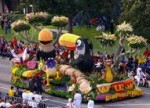 When you watch the Rose Parade at New Years it is hard to imagine that the first such parade in 1890 was the result of the desire of some Pasadena residents to show off the mild and glorious climate of their home town. These residents, members of the Valley Hunt Club, were originally from the East and Midwest and knew well how cold and snowy life back East could be. They were eager to show off their blooming flowers and orange trees in fruit so decided to hold a festival “to tell the world about [their] Paradise.”
When you watch the Rose Parade at New Years it is hard to imagine that the first such parade in 1890 was the result of the desire of some Pasadena residents to show off the mild and glorious climate of their home town. These residents, members of the Valley Hunt Club, were originally from the East and Midwest and knew well how cold and snowy life back East could be. They were eager to show off their blooming flowers and orange trees in fruit so decided to hold a festival “to tell the world about [their] Paradise.”
The early years of the festival featured horse drawn carriages covered in flowers, with races, a polo match, and tug of war, but as time went on ostrich races, bronco busting demonstrations, a chariot race, marching bands, motorized floats and other novelties joined the celebration. Today the parade is dominated by corporate entities and has become a major event and economic bonanza for some.
An estimated 20 million flowers are used to create the floats in addition to other plant material. According to the rules, all surfaces of a float must be covered with natural material. Flowers, seeds, pods, fruits, bark, moss, seaweed and other plant material are all acceptable; dyed or artificial flowers or plant material are not.
Many different kinds of plants are used but roses, of course, are very popular and about 1.5 million are used. Local growers used to supply the majority of the roses but most roses have been coming from Columbia since 1991 when the United States gave Columbia and Ecuador rose growers duty-free access to United States markets in an effort to curb cocaine production. The company Passion Flowers has been chosen as an official rose sponsor. They are headquartered in Miami, have a distribution center in Vista, California, and deal only with Ecuadorian and Colombian farmers.
Mums and carnations are valued for both their color and ability to last without water. Whole flower heads are glued into vast areas of the floats. Likewise, Orchids from Thailand, Singapore, and Hawaii offer a wide range of color and hold well without water. Tulips from Holland and the Pacific Northwest are prized for making woodland settings; blue iris and statice are used to simulate water or to provide the blue needed in patriotic scenes.
Several flowers are used in unusual ways. Strawflowers, South African natives, are dried, ground up in industrial blenders, and used to coat sculptural forms. Marigold petals are valued for their long lasting color and are striped from the flowers, dehydrated and used to add gold, yellow, or orange to a scene. Tall stems of gladiolus are used in mass arrangements but the flowers are also pulled apart and the petals used to highlight the edges of forms, applied to clear plastic to create butterfly wings, and to create the illusion of skin on human forms.
The planning and construction of a float takes about a year. Most of this work is done by two major float building companies who make use of a huge army of volunteers to bring their ideas into reality in the days just before the parade. After the floats are complete, the left over flowers are collected, made into arrangements and distributed to to seniors in rest homes throughout the San Gabriel Valley.
